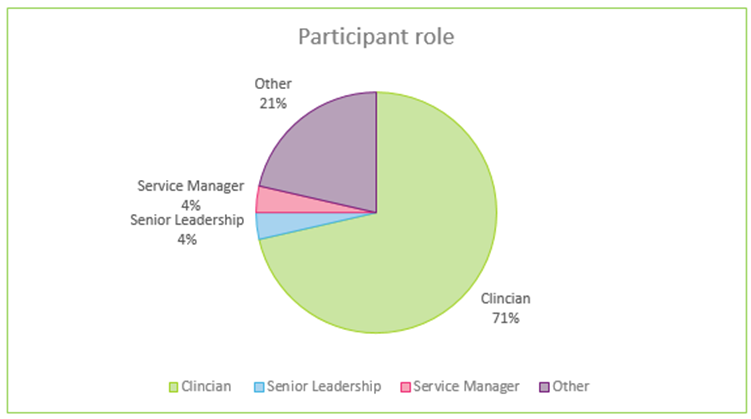Rosa Town, i-THRIVE Grids Assistant Psychologist, discusses the results from the ‘Using i-THRIVE Grids to Improve Shared Decision Making’ i-THRIVE Academy Module pilot.
Download this implementation story.
Background
The i-THRIVE Grids are paper-based decision aids co-produced with young people, parents, and mental health professionals. The grids were funded by a Health Foundation ‘Innovating for Improvement’ grant. They have since been introduced in the North East London NHS Foundation Trust (NELFT) as part of the i-THRIVE Scaling Up Improvement Project, also funded by the Health Foundation. These tools can be used with a young person, a parent, and a mental health professional to facilitate conversation around treatment or care. To date, eight one-page grids have been developed covering low mood, self-harm, ADHD, and generalised anxiety. Five of the grids have received endorsement from NICE as of June 2018.
Decision aids like the i-THRIVE Grids have been shown to increase the likelihood that patients have better knowledge of options and outcomes, feel more comfortable with the choice they make about treatment or care, and have an improved perception of involvement in shared decision making[1]. However, it is important that healthcare professionals are trained to use these tools to ensure that they are being used in accordance with best practice in shared decision making.
The i-THRIVE Grids Academy Module pilot was developed by Rosa Town, Research Officer for i-THRIVE Grids, in collaboration with the National i-THRIVE Programme team and the i-THRIVE Scaling Up Team in NELFT, to train mental health professionals to use the i-THRIVE Grids in their practice. Entitled ‘Using i-THRIVE Grids to Improve Shared Decision Making’, the training includes:
- An overview of the concept of shared decision making
- A recap of the THRIVE Framework for system change (Wolpert et al., 2019) and i-THRIVE
- An introduction to the i-THRIVE Grids
- Skills development activities to practice using the i-THRIVE Grids.
Method
Five two-hour pilot i-THRIVE Grids training sessions were delivered to 35 mental health professionals from February to May 2018. The teams that received training were based in the Tavistock and Portman NHS Foundation Trust or NELFT (Havering CAMHS, Barking and Dagenham CAMHS, and Redbridge CAMHS).
Participants were given 10-15 minutes at both the start and conclusion of the training session to complete feedback forms. Results from the evaluation forms were collated and analysed in SPSS and Excel.
Quantitative results
28 of 35 training attendees (80.0%) filled out the evaluation survey. Of those, 92% (n = 24) of participants indicated that they found the training relevant or very relevant to their current practice.
Figure 1: Breakdown of participant role

Participants rated four questions pre- and post- training. Statistical tests indicated that there was a significant improvement post-training in participants’ responses regarding their readiness to use the i-THRIVE Grids, current knowledge of the i-THRIVE Grids, confidence in explaining shared decision making to a third party, and current knowledge of shared decision making (see Figure 2).
Figure 2: Pre – versus post-training individual question ratings

No significant difference was found for the Leeds Attitude Towards Concordance (LATCon) II Scale[2] also used in the evaluation, which was designed to measure healthcare practitioners’ attitudes toward understanding and respecting patients’ preferences.
Qualitative results
Participants in the training were also invited to provide additional qualitative feedback about the training, and example responses are given below.
For the question, “How do you plan to take the learning from today back to your organisation?”, participants indicated that they planned to use the i-THRIVE Grids in a variety of settings and share them with their colleagues.
Figure 3: How do you plan to take the learning from today back to your organisation?

Participants stated that the training session met their expectations as it provided useful and clear information related to the i-THRIVE Grids and shared decision making.
Figure 4: Did this session meet your expectations? If so, how? If not, in what way?

Participants described a number of things that worked well in the training session, including having the opportunity to practice using the grids, learning background information and research about shared decision making, having a well-prepared facilitator, and having the opportunity to discuss the grids as a group and apply them to current work.
Figure 5: What worked well in this session?

Participants were also asked what could be improved the next time the training is run. However, this question yielded few responses. Among these were requests for refreshments at future trainings, for a shorter training evaluation survey, and for more time to practice using the i-THRIVE Grids.
The most meaningful takeaways from the session for participants included the importance of shared decision making, how easy and useful the grids were, and how the grids could be used flexibly and at the clinician’s discretion.
Figure 6: What is the most meaningful takeaway from today?

Future directions
This evaluation indicated that the pilot training of the i-THRIVE Grids successfully enhanced participants’ knowledge and understanding of the i-THRIVE Grids and shared decision making. The ‘Using i-THRIVE Grids to Improve Shared Decision Making’ module will be available as an i-THRIVE Academy Module for services seeking to focus on improving shared decision making. Further information on how to sign up for this training is available here.
If you would like further information about the i-THRIVE Grids, please contact Rosa Town at rtown@tavi-port.nhs.uk.
Acknowledgements
Special thanks to Dr Rachel James, Dr Liz Searle, and Dr Emilios Lemoniatis who donated their time to help design and facilitate the pilot trainings.
[1] Stacey, D., Légaré, F., Lewis, K., Barry, M.J., Bennett, C.L., Eden, K.B., Holmes-Rovner, M., Llewellyn-Thomas, H., Lyddiatt, A., Thomson, R., & Trevena, L. (2017). Decision aids to help people who are facing health treatment or screening decisions. Cochrane Database of Systematic Reviews.
[2] Knapp, P., Raynor, D.K., Thistlethwaite, J.E., Jones, M. B. (2009). A questionnaire to measure health practitioners’ attitudes to partnership in medicine taking: LATCon II. Health Expectations, 12, 175-86.
Edited by the National i-THRIVE Programme Team.
Written June 2018.